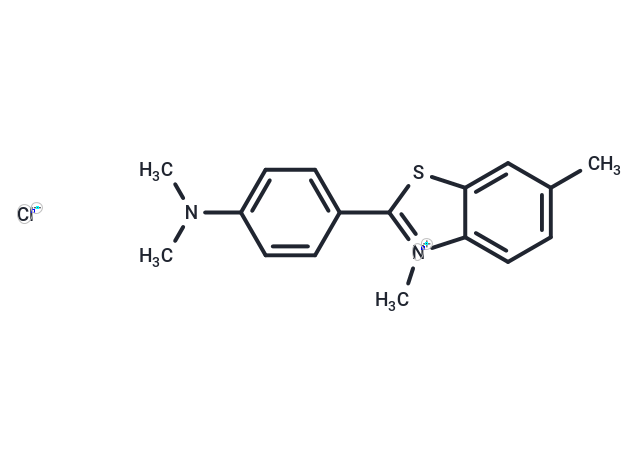Shopping Cart
Remove All Your shopping cart is currently empty
Your shopping cart is currently empty
Thioflavin T (Basic Yellow 1) is a widely used dye for visualizing and is a cationic Benzothiazole dye that shows enhanced fluorescence upon binding to amyloid in tissue sections.

| Pack Size | Price | USA Warehouse | Global Warehouse | Quantity |
|---|---|---|---|---|
| 1 g | $29 | In Stock | In Stock | |
| 1 mL x 10 mM (in DMSO) | $29 | In Stock | In Stock |
| Description | Thioflavin T (Basic Yellow 1) is a widely used dye for visualizing and is a cationic Benzothiazole dye that shows enhanced fluorescence upon binding to amyloid in tissue sections. |
| In vitro | Thioflavin T (ThT), a benzothiazole dye, notably increases in fluorescence when bound to amyloid fibrils, facilitating their diagnosis both ex vivo and in vitro. This fluorescence enhancement is influenced by micelle formation, with ThT micelles—measuring about 3 nm in diameter—visually confirmed along fibrils using atomic force microscopy. These ThT micelles bind to amyloid fibrils, significantly enhancing fluorescence emission. In aqueous solutions at concentrations typical for fluorescence assays (~10-20 μM), ThT exists as micelles, with its critical micellar concentration determined to be 4.0±0.5 μM. As ThT concentration rises above this threshold, more micelles are observed binding along the amyloid fibrils. However, at low pH, ThT micelle formation is disrupted, and fluorescence enhancement upon binding to amyloid fibrils decreases several-fold, especially below pH 3. |
| Cell Research | Instructions I. Solution preparation 1. Stock solution: Dissolve Thioflavin T in deionized water or an appropriate buffer solution, usually prepared as a 1–10 mM stock solution. PBS (pH 7.4) can also be used as a solvent as needed. In aqueous solution, Thioflavin T is found in the form of micelles at concentrations typically used to monitor fibrils by fluorimetry (~10 -20 μM). 2. Working solution: Dilute the stock solution to an appropriate working concentration, usually 10–50 µM, for tissue section or cell staining, depending on experimental requirements. II. Application steps Tissue section staining: 1. After fixing and dewaxing tissue sections, treat the sections with Thioflavin T working solution. 2. Soak the sections in Thioflavin T solution and usually stain for 10-30 minutes. 3. Rinse the sections with PBS or distilled water to remove excess dye. 4. Observe the fluorescence of the sample, using an appropriate excitation wavelength (usually 450–480 nm) and a fluorescence emission wavelength of 520–550 nm. 5. Cell staining: 1) Culture the cells in an appropriate culture medium and fix them. 2) Stain the cells with 10–50 µM Thioflavin T working solution, usually for 10–30 minutes. 3) Rinse the cells with PBS to remove excess dye. 4) Observe amyloid aggregates in the cells using a fluorescence microscope, usually under cyan light excitation. 5. Calibration and control 1) Control group: Set up a sample without Thioflavin T as a control to ensure the specificity of the staining. 2) Standard curve: Establish a standard curve between fluorescence intensity and protein concentration using amyloid samples of known concentrations. Notes 1) Photosensitivity: Thioflavin T is a photosensitive dye. Avoid strong light exposure during the experiment to prevent fluorescence signal attenuation. 2) Storage conditions: Thioflavin T should be stored in a dark, dry place, usually at -20°C. 3) Solubility: Thioflavin T usually dissolves well in water or PBS, but avoid residual insoluble matter in the solution. |
| Synonyms | Basic Yellow 1 |
| Molecular Weight | 318.86 |
| Formula | C17H19ClN2S |
| Cas No. | 2390-54-7 |
| Smiles | [Cl-].CN(C)c1ccc(cc1)-c1sc2cc(C)ccc2[n+]1C |
| Relative Density. | 1.301 g/cm3 at 20℃ |
| Storage | keep away from moisture,keep away from direct sunlight | Powder: -20°C for 3 years | In solvent: -80°C for 1 year | Shipping with blue ice/Shipping at ambient temperature. | ||||||||||||||||||||||||||||||||||||||||
| Solubility Information | H2O: 12.5 mg/mL (39.2 mM), Sonication is recommended. DMSO: 51.5 mg/mL (161.51 mM), Sonication is recommended. | ||||||||||||||||||||||||||||||||||||||||
| In Vivo Formulation | 10% DMSO+40% PEG300+5% Tween-80+45% Saline: 1.67 mg/mL (5.24 mM), Sonication is recommeded. Please add the solvents sequentially, clarifying the solution as much as possible before adding the next one. Dissolve by heating and/or sonication if necessary. Working solution is recommended to be prepared and used immediately. The formulation provided above is for reference purposes only. In vivo formulations may vary and should be modified based on specific experimental conditions. | ||||||||||||||||||||||||||||||||||||||||
Solution Preparation Table | |||||||||||||||||||||||||||||||||||||||||
H2O/DMSO
DMSO
| |||||||||||||||||||||||||||||||||||||||||
| Size | Quantity | Unit Price | Amount | Operation |
|---|

Copyright © 2015-2025 TargetMol Chemicals Inc. All Rights Reserved.